Alkah-teke
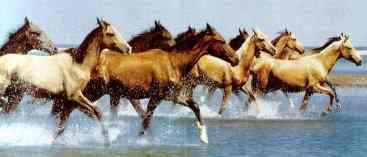
Conformation
1.
Head: proportional to body, light, dry with wide cheeks, nose line straight or
convex.
Eyes are large, expressive and often hooded. Ears are set high long
and thin and very alert.
Lips and nostrils are thin and dry.
2. Neck:
set high on shoulders. Long, straight and lean.
3. Withers: high, long and
well muscled.
4. Back and loin: straight and long.
5. Croup: wide, long
and with a normal sloping angle.
6. Tail: set low, sparse hair growth.
7.
Shoulders: Long shoulder with good slope and very clean shoulder bed.
8. Legs:
long, dry and dense with clearly defined sinews.
9. Pasterns: long and elastic
without softness.
10. Chest: Not too deep.
11. Hooves: small and hard.
12.
Fetlock: little to no hair.
General
impression: Full of grace and elegance with its naturally high head carriage,
long
beautifully shaped ears, always alert. The skin is thin and the coat,
fine and silky with a
golden, almost metallic hue. Known for its hardiness,
endurance and beauty. A natural athlete
and equine aristocrat.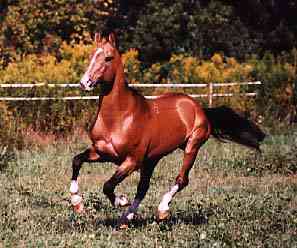
Akhal-Teke
colours
Bay
Black
Buckskin
Cremello
Golden Light
Bay
Golden Palomino
Grey
Palomino
Perlino
Snake eyes
& Blue eyes
Sorrel 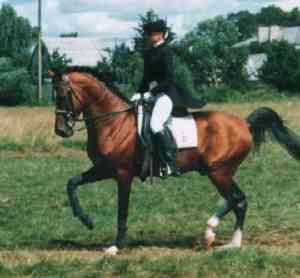
History
One
of the most ancient and unique breeds of the world the Akhal-Teke was created
in Southern Turkmenia by the "Teke" tribe on the "Akhal" oasis.
It is the most distinctive strain of the ancient race of horses known as the Turkoman
or Turkmene. Directly descended from the wild steppe horse, the Turkoman is the
legendary horse from Fergana and Bactria where it was called the Bactrian or Turanian
horse and used by the great leaders Darius and Alexander. The cavalry of Darius
was mounted on this "horse of quality" and very successful because of
it. In Chinese legends it was known as the "heavenly horse" and the
"horse that sweats blood". The Chinese attacked Bactria in 126 B.C.
solely to obtain some of these "heavenly blood sweating horses", such
was their reputation.
Located in Southern Turkmenistan, away from the trade routes, bordered by the Kara Kum desert and Kopet Dag mountains, the Akhal oasis is in an area not subjected to continual conquest or occupation. This isolation, along with the great pride the Teke tribesmen took in the purity of their: horses has produced a breed of ancient line's and great purity.
As the chief mount of Turkoman warriors for centuries, the Akhal-Teke developed endless stamina and, from the harsh desert environment, the ability to withstand great extremes of temperature. With fresh forage available only three months of the year in the arid desert the Teke tribesmen developed their own special methods of horse managem nt. Kept in small bands, tethered to stakes and blanketed, the Akhal. Teke were fed pellets consisting of alfalfa, barley and mutton fat. This type of management resulted in a horse that can subsist on small amounts of food and water, becomes devoted to its master and is suspicious of strangers. Being outside continuously the blanketing protected them from the extreme swings in desert temperatures. The blanketing also enhanced the metallic sheen of their coat which is a source of great pride for the owners. The prevailing color is gold; either as golden dun, golden bay or golden chestnut though other colors do occur. This special golden color with a metallic sheen is genetically distinct and is a unique characteristic of the breed.
The
Akhal-Teke is a true desert bred horse with a light, elegant build and an original
and distinctive conformation: long, tapering, aristocratic face; beautifully shaped
mobile ears; wide nostrils and large expressive eyes having a proud fiery gaze,
The neck is straight, long and often thin, set high on excellent sloping shoulders.
Very prominent withers; body long, lean, narrow and sinewy with pronounced croup
and sloping hindquarters. Legs long and dry; good forearms and hocks well let
down with short cannons of dense bone; the hooves are small with a thick wall
of strong horn. A characteristic feature is the sparse short mane and forelock
and absence of feather on the legs. The skin is very thin with a short, fine and
silky coat. The overall effect is of the long, lean grace of a greyhound. Magnificent
action, free and flowing: in all paces a soft, gliding, elastic stride. Quiet
temperament, but easily aroused. Bold, Alert and intelligent; responding well
to sensitive training. Normal height 15 to 16hh, weight 900 to 1000 pounds. 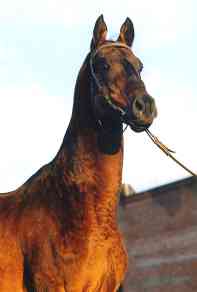
Originally
bred as war mounts, then for racing the Akhal-Teke now is used in all competitive
equine sports such as endurance, dressage, jumping and eventing. They are also
used extensively in circuses. In the 1960 Olympics, ABSENT an Akhal-Teke stallion
won the gold medal in dressage with Sergai Filytov riding. By the end of his career,
ABSENT had won six Olympic dressage medals, more than any other horse. In Russia,
Akhal-Teke stallions are used for upgrading local breeds and for producing warm
blooded sport horses when crossed with larger coarser stock. It is just now being
recognized that the Akhal-Teke played a substantial part in the creation of many
of todays light breeds while being referred to as an Arabian: Arabian in those
days being a generic term for any horse of middle east origin. It is interesting
to speculate about the role the Akhal-Teke played in the development of the Thoroughbred.
Careful study of what is known of the Byerley Turk indicate it was most probably
an Akhal-Teke and that the Darley Arabian was of the Muniqi strain of Arabians
and carried a large portion of Akhal- Teke blood. 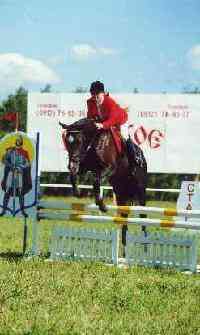
Early in this century the purity of the breed was threatened as thoroughbred stallions were introduced in some lines in an attempt to improve the racing speed. Fortunately, in 1935 the purebreds proved their endurance and stamina in the famous 2700 mile trek from Ashkabad to Moscow which they covered in 84 days. At one point they crossed 225 miles of desert in 3 days, virtually without water. This convinced the authorities the Akhal-Teke should be preserved in its pure form and all outcrossing was stopped. The Russians now consider the Akhal-Teke part of a genetic fund of exceptional value, a remnant of that precious fund that gave rise to breeding of saddle horses throughout the world.
Today the Akhal-Teke is quite rare
by modern breed standards, with less than 2000 existing worldwide. The major
population of about 1400 is in Russia, with the second largest group of about
200 in West Germany. In the United States there are fewer than 100.